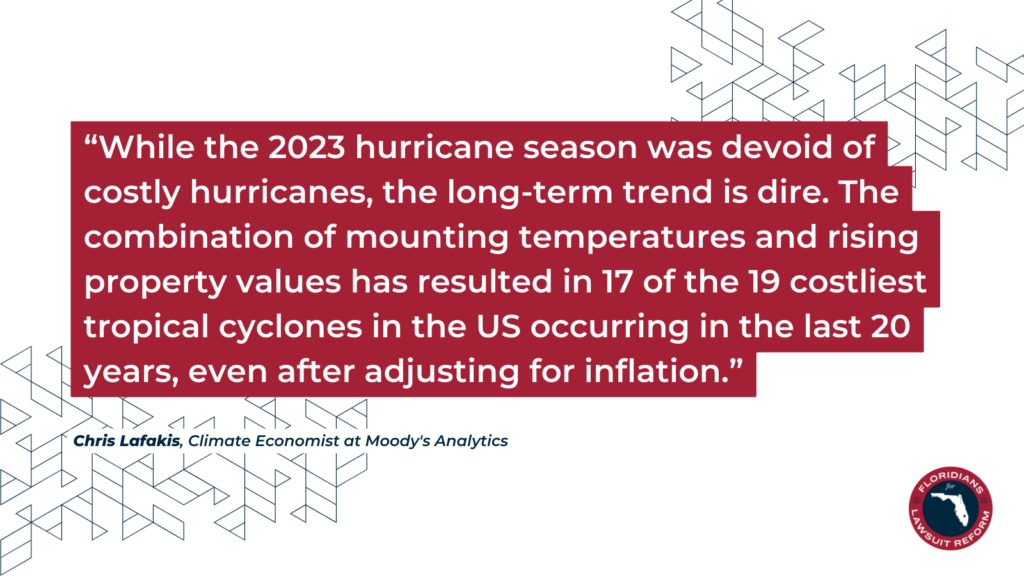
A very active Atlantic hurricane season is predicted for 2024, which could potentially have profound effects on the re/insurance, CRE, and supply chain sectors, as well as on credit worthiness and general economic strength for particular global regions and for broader markets, according to Moody’s.
Since 2017, when the 12-year hurricane drought ended, North Atlantic Hurricanes have cost the insurance industry $275 billion in insured losses, Julie Serakos, Insurance Managing Director explained.
With the increased population in coastal areas, as well as other factors like social inflation, construction inflation, and regulatory mandates, event losses have escalated.
22 named storms are projected on average for 2024, compared to the historical average of 14 named storms per year between 1991 and 2020, according to experts. Munich Re anticipates approximately 23 named cyclones in the tropical North Atlantic, with roughly 11 of those potentially developing into hurricanes, of which five might become severe hurricanes, reaching wind speeds of over 110 mph (177 km/h).
“While the 2023 hurricane season was devoid of costly hurricanes, the long-term trend is dire,” said Chris Lafakis, Climate Economist, Moody’s Analytics. “The combination of mounting temperatures and rising property values has resulted in 17 of the 19 costliest tropical cyclones in the US occurring in the last 20 years, even after adjusting for inflation.”
Lafakis continued: “Moreover, NOAA estimates that the total cost of US billion-dollar disasters over the last 5 years (2018-2022) is $595.5 billion, with a 5-year annual cost average of $119.1 billion, the latter of which is nearly triple the 43-year inflation adjusted annual average cost.
“These costly storms also threaten to destabilise the insurance market, as an increasing number of private insurers abandon some or all parts of expensive property markets such as California and Florida.”
Adam Kamins, Senior Regional Economist for Moody’s Analytics, has similar opinions, noting that, if forecasters are correct, 2024 might see a catastrophic hurricane season, especially as there are very few signs of a slowdown in building in high-risk coastal areas.
Because of this, he believes that a major storm would have significant consequences, not only in terms of the human toll but when it comes to lost output and property damage.
The CRE industry would also be affected by the hurricane season, as it could arrive at a time when the industry is struggling with affordability challenges and availability of insurance.
Natalie Ambrosio Preudhomme, Associate Director-Commercial Real Estate, stated: “Exposure to a strong storm could affect ongoing conversations around risk appetite and alternative risk transfer for lenders and borrowers.
“Meanwhile, every passing hurricane season informs our broader understanding of the shifting long-term viability of coastal real estate markets, painting a more detailed picture of risk, resilience, recovery, asset value and insurability in areas exposed to hurricanes.”
Despite all these, there are some positive views, as it has also been stated that reinsurers are entering the 2024 hurricane season “well positioned, with strong capital”, as James Eck, Moody’s Vice President-Senior Credit Officer, Financial Institutions, highlighted.
He continued: “Property catastrophe pricing remains high, although more competition is entering the market, particularly at the top end of reinsurance programs. Reinsurance terms and conditions generally remain firm, with primary insurers retaining more risk at lower return periods.”
John Donigian, Senior Director, Supply Chain Strategy, shares similar views as Eck, noting that even though this year’s hurricane season is forecasted to be more severe, and could affect supply chains, good risk mitigation strategies are in place.
He said: “The upcoming Atlantic hurricane season poses challenges to supply chains at a time when they are already trying to manage ongoing risks and build resiliency. Port and airport closures, damage to key infrastructure, and clogged highways resulting from evacuations can slow logistics and impede the flow of goods.
“Facilities located in a hurricane path can suffer production halts and inventory losses. Supply chain expenses can also be affected if a spike in insurance claims leads to increased premiums for businesses, or a scarcity of goods causes costs to rise.”
Donigian concluded: “While hurricane season now starts earlier and is more severe, companies along the Gulf Coast and U.S. East Coast have ample experience employing risk mitigation strategies, such as positioning goods bought in distribution centers outside of the anticipated hurricane path.
“Risks – including repetitive disruption, facility damage, and lost revenue and expenses – should prompt companies to continue redesigning their supply chain networks and diversifying key servicing nodes and suppliers to limit exposure to these danger zones.”
